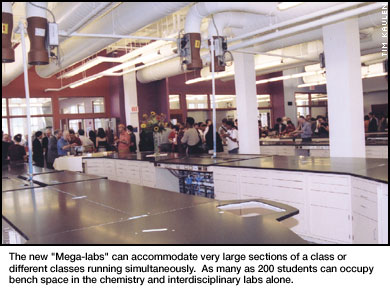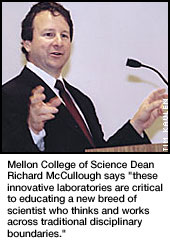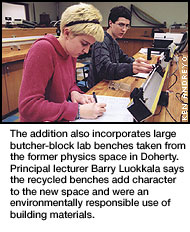|
|
||||
|
|
 Interdisciplinary Labs Designed to Better Prepare 21st Century Scientists Carnegie Mellon students entering the Mellon College of Science's (MCS) new interdisciplinary undergraduate science laboratories this spring are encountering a dynamically designed environment aimed at better preparing scientists for the 21st century. "These innovative laboratories are critical to educating a new breed of scientist who thinks and works across traditional disciplinary boundaries," said MCS Dean Richard McCullough, an instrumental player in designing the laboratories. "The experience these facilities allow will be central to our students' success."
Each student station has a data port for network access, and computers in each lab can be shared by students in the class. Some computers are on mobile carts allowing students to readily move back and forth from their bench experiment to a computer to analyze data. These enhanced capabilities are critical to conducting experiments such as computational prediction and modeling of physical phenomena, or running programs in computational chemistry. The lab design also facilitates sharing of equipment and instrumentation, and collaborative efforts that span sub-disciplines or that pair less experienced students with senior peers in mentoring relationships. "Prior to the new interdisciplinary labs, physics had one large space in Doherty, and this area had to serve many different functions," said Principal Lecturer Barry Luokkala, director of undergraduate labs in the Physics Department and program director for the Pennsylvania Governor's School for the Sciences held on campus each summer. "We had to improve and modify this large but inefficiently designed space to make it accommodate as many activities as possible.
"The setup of our laboratories in terms of design and attention to detail is novel," said Principal Lecturer Karen Stump, director of undergraduate studies and laboratories for the Chemistry Department, and director of the Pennsylvania Governor's Institute for Physical Science Educators. "It's unlike anything else we visited when we were planning the facilities." The floors are configured to accommodate learning and teaching. Levels 1 and 3 house instruments on mobile carts and have unique overhead utility grids to ensure that space can be easily reconfigured as new instrumentation is acquired. The new second-level lecture hall is equipped with a movable glass-sided fume hood for lecture demonstrations and bench-type seating for small hands-on activities. Also on this level is an outreach laboratory—the first on campus—designed to house a variety of MCS outreach programs, science fair projects and senior projects. The new addition also incorporates a bit of the old, in the form of large butcher-block lab benches taken from the former physics space in Doherty. These recycled benches add character to the new space and "were an environmentally responsible use of building materials," Luokkala said. This spring undergraduates in the labs are conducting a forensic analysis of a mock poisoning. Students are using a variety of analytical techniques to identify a suspected poison, measure its concentration, and compare their results with symptoms experienced by a make-believe patient.
"The forensics analysis is just the type of quality undergraduate learning experience that sets us—and these new interdisciplinary labs—apart from other academic institutions," Stump said. "We have an exceptional setup to investigate real-world scientific problems by integrating a variety of analytical approaches, and we can modify our teaching and laboratory methods in the face of changing technology."
Lauren Ward
|
||
|
Carnegie Mellon Home |
||||
 "Mega-labs," which occupy four levels of the new eight-story, 100,000 square-foot addition to Doherty Hall, can accommodate very large sections of a class or different classes running simultaneously. As many as 200 students can occupy bench space in the chemistry and interdisciplinary labs alone.
"Mega-labs," which occupy four levels of the new eight-story, 100,000 square-foot addition to Doherty Hall, can accommodate very large sections of a class or different classes running simultaneously. As many as 200 students can occupy bench space in the chemistry and interdisciplinary labs alone.
 "With the completion of the new labs, as well as renovations in Doherty, we now have facilities designed to accommodate the many things we do. Consequently, we can do them much better, and it is easier to do several activities simultaneously," Luokkala said.
"With the completion of the new labs, as well as renovations in Doherty, we now have facilities designed to accommodate the many things we do. Consequently, we can do them much better, and it is easier to do several activities simultaneously," Luokkala said.